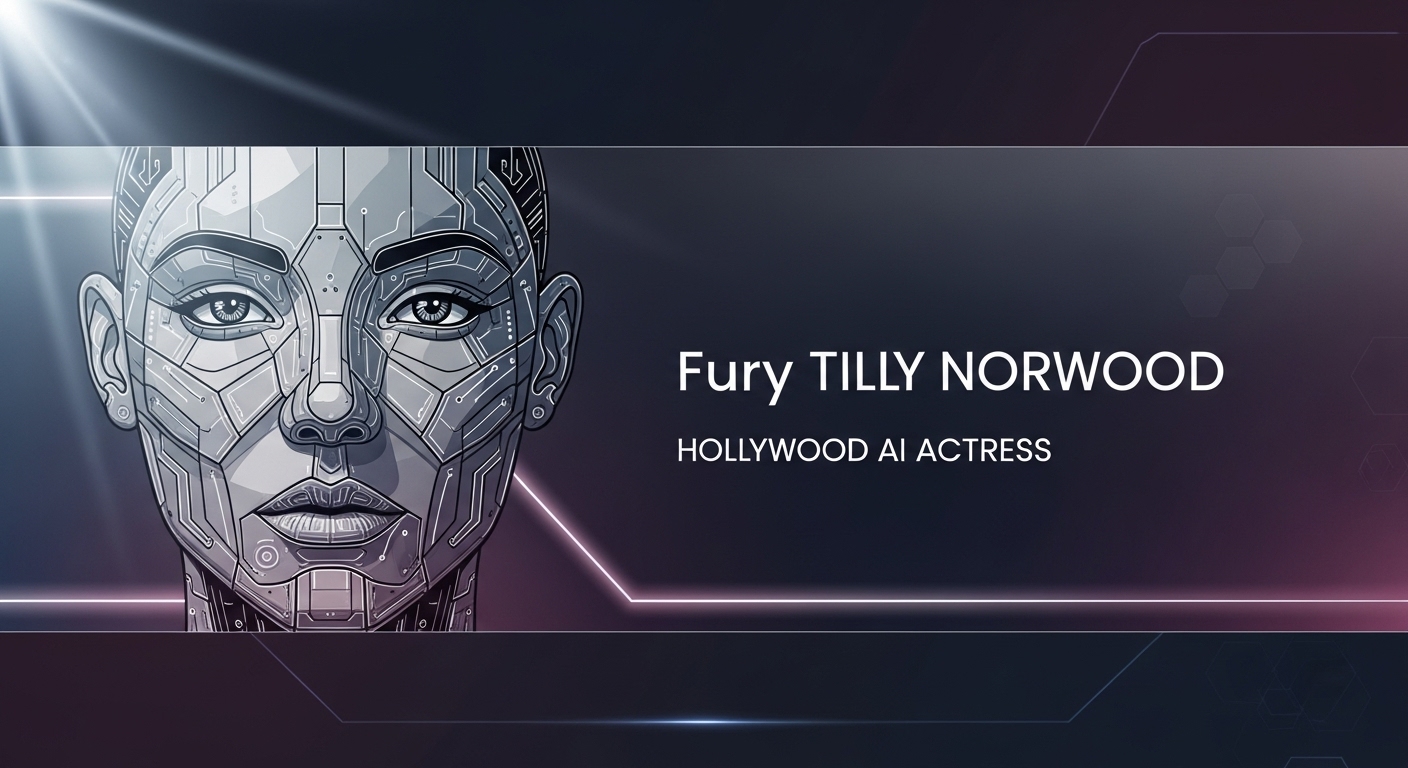ハリウッドは新たな「AI女優」に激怒している!?エンタメ業界の未来を揺るがす波紋
近年、テクノロジーの進化は私たちの生活のあらゆる側面に浸透し、エンターテインメント業界も例外ではありません。特に、人工知能(AI)の台頭は、これまで人間が担ってきたクリエイティブな職種にも大きな変化をもたらしています。そして今、ハリウッドでは新たな「AI女優」の登場を巡って、激しい議論と怒りが巻き起こっています。
AI女優「ティリー・ノーウッド」の衝撃的なデビュー
この議論の中心にいるのが、AI制作会社Particle6とそのAIタレントスタジオXicoiaが生み出したAI女優「ティリー・ノーウッド」です。彼女のデビューは2025年9月、チューリッヒ国際映画祭で正式に発表され、瞬く間に世界中の注目を集めました。ティリー・ノーウッドは、すでにコメディ短編映画に出演し、Instagramでは多くのフォロワーを獲得しています。そのリアルな表情生成や自然な動きは、生成AI技術の驚異的な進歩を象徴しています。
ティリーの生みの親であるエリーヌ・ファン・デル・フェルデン氏は、彼女を「人間の代替品ではなく、創造的な作品、つまり芸術作品の一部」と位置づけ、AIを「新しいツール、新しい絵筆」として捉えています。彼女は、アニメーションやCGIが物語表現の可能性を広げてきたように、AIも新たな物語創造の手段となると主張しています。
ハリウッド俳優たちの激しい反発と労働組合の動き
しかし、ハリウッドの反応は冷ややかどころか、強い怒りをもって迎えられました。多くの俳優たちが、AI女優の登場が自分たちの仕事を奪い、芸術性そのものを損なうものだと危機感を募らせています。女優のメリッサ・バレラ、エミリー・ブラント、ナターシャ・リヨンらは、AIキャラクターと契約するエージェンシーをボイコットするよう呼びかけるなど、強硬な姿勢を示しています。
特に、全米映画俳優組合(SAG-AFTRA)は、ティリー・ノーウッドを「俳優ではない」と公式に非難し、「創造性は人間中心であり、今後もそうあり続けるべきだ」と声明を発表しました。 2023年には、SAG-AFTRAが全米脚本家組合(WGA)と同時期に大規模なストライキを敢行しましたが、その主要な争点の一つがAIの利用制限と、俳優の肖像権・声の権利保護でした。このストライキの結果、俳優のデジタル複製を利用する際には本人の同意と公正な対価を支払うことが盛り込まれるなど、AIに関する契約上の保護が確立され始めています。
AIモデルの訓練に既存の著作物が無許可で使用されることに対する倫理的・法的な懸念も高まっており、SAG-AFTRAを含む多くのクリエイターや出版社が、AI学習におけるコンテンツの無許可使用に反対する公開書簡に署名しています。
AI女優のメリットとデメリット
AI女優には、エンターテインメント業界にとって魅力的な側面がある一方で、無視できないデメリットも存在します。
メリット:
- **コスト削減と制作効率の向上**: 撮影スケジュールやギャラ交渉といった複雑なプロセスが不要となり、制作コストを大幅に削減できる可能性があります。危険なシーンや特殊な役柄も、AIであれば容易に実現できます。
- **24時間稼働と柔軟なイメージコントロール**: AIは時間や場所に縛られず「活動」でき、外見や演技も自由に調整・変更が可能です。不祥事のリスクもありません。
- **多様な表現と創造性の拡大**: 人間には不可能な表現や、多言語での演技も容易に実現でき、新たな物語表現の可能性を広げます。
デメリット:
- **雇用の喪失**: 最も懸念されるのは、AIが人間の俳優、特にエキストラやバックグラウンドパフォーマーの仕事を奪うことです。これは、多くの俳優たちの生活基盤を脅かしかねません。
- **人間らしさの欠如と倫理的課題**: AIキャラクターは真の感情や経験を持たないため、観客が本物の感情移入をできるのかという疑問が呈されています。また、故人の肖像権や、既存の作品を学習データとして利用する際の著作権問題など、倫理的・法的な課題も山積しています。
- **技術的問題と信頼性**: まだ進化の途上にあるAI技術は、不自然な動きや表現を生み出す可能性もあり、作品の質に影響を与えることも考えられます。
エンタメ業界の未来はどこへ向かうのか
AI女優の登場は、ハリウッドに単なる一時の騒動ではなく、エンターテインメント業界全体の未来を問う根本的な問いを投げかけています。AIを人間の代替物ではなく、創造性を拡張する「道具」として活用する道を探るのか、それとも人間の芸術性と雇用を守るための厳格な規制を設けるのか。
SAG-AFTRAが一部のAI音声技術企業と契約を結び、俳優の権利を保護しながらAI利用の道を探っている例もありますが、この議論はまだ始まったばかりです。今後、AI技術のさらなる発展と、業界団体、クリエイター、そしてテクノロジー企業間の対話を通じて、新たなルールや共存の形が模索されていくことでしょう。
ハリウッドにおけるAI女優を巡る激論は、創造性とテクノロジーが交差する現代社会において、人間中心の価値観をどう守り、いかに新たな可能性を切り開いていくかという、私たち全員に共通する課題を浮き彫りにしています。
Hollywood’s New Leading Lady: An AI Actress Stirs a Storm
The dazzling lights of Hollywood have always been synonymous with human talent, raw emotion, and unparalleled storytelling. Yet, a new kind of star is emerging from the digital ether, one composed not of flesh and blood, but of algorithms and data. The rise of the “AI actress” has sent shockwaves through the entertainment industry, sparking intense debate, outrage, and urgent calls for regulation. Is this the dawn of a new creative era, or a perilous path toward devaluing human artistry?
The Debut of Synthetic Stars and Their Creative Promise
Central to the current controversy is Tilly Norwood, an AI-generated character whose debut has captured global attention and ignited a firestorm in Hollywood. Created by Dutch actor and producer Eline Van der Velden’s AI talent studio, Xicoia, Tilly Norwood is presented as a “hyperreal digital star” with aspirations across film, television, and social media. Her creator champions AI as a “new paintbrush,” a powerful tool capable of expanding creative possibilities without necessarily diminishing live performance.
Indeed, proponents of AI in filmmaking point to numerous potential benefits. Artificial intelligence is already being integrated into various stages of production, from initial script conception and character design to advanced visual effects and post-production processes. This integration promises enhanced efficiency, significant cost reductions, and the ability to realize unprecedented visuals. AI tools can streamline demanding workflows, accelerate innovation, and even democratize filmmaking by making professional-grade tools accessible to a broader range of creators. For instance, AI can assist in everything from analyzing audience preferences for script optimization to performing complex de-aging effects on actors, as seen in films like “The Irishman”. The potential to generate unique new content, revive historical figures, or create entirely new fictional beings with realistic expressions is vast, offering fresh avenues for narrative exploration.
Hollywood’s Human Backlash: A Threat to Artistry and Livelihoods
However, the enthusiastic embrace of AI by some industry segments has met fierce resistance from the very heart of Hollywood: its actors, writers, and unions. The Screen Actors Guild-American Federation of Television and Radio Artists (SAG-AFTRA) has issued strong statements unequivocally opposing the replacement of human performers by synthetic ones. The union stresses that “Tilly Norwood” is not an actor but a computer program, trained on the performances of countless professionals, often without their permission or compensation. SAG-AFTRA highlights that AI creations lack “life experience to draw from, no emotion,” and that audiences are unlikely to be genuinely interested in computer-generated content “untethered from the human experience”. They argue that such AI models don’t solve problems but rather create new ones by potentially “using stolen performances to put actors out of work, jeopardizing performer livelihoods and devaluing human artistry”.
Prominent Hollywood figures have been vocal in their condemnation. Whoopi Goldberg, for example, articulated concerns about the unfair advantage AI actresses pose, potentially being generated from the composite likenesses and performances of thousands of real actors. “You can always tell them from us. We move differently, our faces move differently, our bodies move differently,” she stated. Actress Emily Blunt called the development “really, really scary,” while Melissa Barrera publicly criticized talent agents considering signing AI actresses, urging human actors to drop such agencies. These sentiments underscore a profound anxiety about job displacement, the erosion of intellectual property rights, and the ethical implications of creating or altering images and voices of individuals without consent. The core question remains: can an algorithmically generated avatar truly be called an “actress,” or is that term reserved for living, breathing professionals who imbue characters with genuine human emotion and experience?
Navigating the AI Frontier: Union Efforts and Ethical Frameworks
In response to these burgeoning concerns, unions like SAG-AFTRA have been proactive in negotiating safeguards for their members. Throughout the challenges posed by AI, the union has engaged in significant discussions and reached landmark agreements to protect performers’ rights. For instance, agreements for the use of AI voices in video games and commercials now include robust protections, requiring explicit consent from performers before their likeness or voices can be replicated digitally and mandating fair compensation for such uses. These agreements also establish rules for “synthetic performers” (digitally-created assets trained on human actors), requiring union notification, bargaining, and compensation.
Beyond contractual protections, there’s a growing movement to establish ethical frameworks for AI use across the entire film industry. Discussions revolve around ensuring transparency, addressing potential biases in AI algorithms, preventing misinformation, and upholding humanistic care in content creation. Organizations like the Archival Producers Alliance (APA) have even released ethical guidelines for filmmakers, particularly in documentary production, to address concerns over “fake archival” materials and to reaffirm journalistic values in an AI-driven landscape. The goal is to strike a crucial balance between embracing technological innovation and upholding creative integrity.
The Future of Entertainment: Coexistence or Replacement?
The debate surrounding AI in Hollywood is far from over, presenting a complex challenge that forces the industry to confront the very definition of “artistry.” While some, like Ben Affleck, suggest AI won’t destroy the film industry but rather contribute to its evolution, the underlying tension between AI as a tool and AI as a replacement persists. Studio executives are reportedly moving forward with AI projects, anticipating more announcements in the coming months, highlighting the industry’s quiet but steady adoption of these technologies.
The path forward will likely involve a delicate dance between technological advancement and the preservation of human creativity. It necessitates robust ethical standards, fair labor practices that ensure consent and equitable compensation, and a continuous appreciation for the irreplaceable human element in storytelling. The aim should be to leverage AI to augment, rather than diminish, the human essence of filmmaking, ensuring that as technology evolves, the heart and soul of Hollywood remain firmly human.



